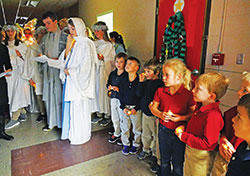2018 Catholic Schools Week Supplement
Latino Outreach Initiative helps schools invite, support Latino families

Students of St. Bartholomew School in Columbus participate in a Las Posadas procession on Dec. 18, 2017. The procession is a traditional Mexican Advent celebration that re-enacts Mary’s and Joseph’s search for a room in Bethlehem, and commemorates the nine months during which Mary carried Jesus in her womb. The procession is just one way in which the school, a member of the archdiocese’s new Latino Outreach Initiative, is seeking to invite and support their Latino students and families. (Submitted photo)
By Natalie Hoefer
Phillip Gonzalez believes in the benefits of Catholic education for Latinos, and he has the numbers to back up his belief.
“A number of studies have shown [that] Latino students who attend Catholic school are 42 percent more likely to graduate from high school, and 2.5 times more likely to graduate from college,” he says.
But he also has numbers showing that few Hispanics are reaping those benefits.
“Within a time frame of 2000-2010, the Indiana Hispanic population grew by 82 percent,” Gonzalez notes, quoting a statistic from an article produced by the Indiana Business Research Center in July 2013. Yet according to a University of Notre Dame study, only 3 percent of Catholic Latinos nationally are sending their children to a Catholic school.
To help that situation in central and southern Indiana, the archdiocesan Office of Catholic Schools started a new Latino Outreach Initiative in 2017. Gonzalez serves as the initiative’s coordinator.
The goal of the program is “to support the evangelization of Latino students through the ministry of Catholic schools,” he says. “We accomplish that purpose by inviting Latino students and families into our schools and showing them they’re welcome and included, and by ensuring our schools have the academic and developmental means to meet their needs.”
The program started with a pilot group of five schools selected from among a group of applicants: Our Lady of Providence Jr./Sr. High School in Clarksville; St. Bartholomew School in Columbus; and Father Thomas Scecina Memorial High School, Roncalli High School and St. Lawrence School, all in Indianapolis. Gonzalez hopes to expand the Latino Outreach Initiative to other schools over time.
Helen Heckman, principal of St. Bartholomew School, says her goal in participating in the program is to better serve the needs of the school’s Latino population of 28 percent.
“The reason I wanted to take part in the initiative is to feel like we were doing everything possible so [Hispanic] families at our school feel welcome and [feel] that we want them to be part of our school and [that] we respect their heritage.”
Projects that St. Bartholomew has undertaken through the initiative include hiring more bilingual employees; starting a soccer team; updating signs to include Spanish; and offering professional development in cultural awareness to all staff. Even though the initiative is just getting underway, Heckman says she’s already noticed a difference.
“Now that [Latinos] have seen the effort we’ve put in to better serving them, the benefit is that they want to give back more,” she says. “We’ve seen more volunteers and more effort to help wherever they can.”
At Scecina, president Joseph Therber hopes the Latino Outreach Initiative will help the school to better serve “an increasing number of Latino students, including a number of Latino families in the [Indianapolis] East Deanery parishes.”
The initiative has already led to three plans at Scecina: having an existing bilingual staff member translate documents and conversations; adding displays reflecting Latino culture to the existing displays in the school’s main hall; and identifying a madrina—Spanish for “godmother.”
The latter plan reflects the Madrinas Model, which promotes schools engaging a trusted woman from the Latino community to develop and strengthen the connection between the school and Latino families.
Member schools participating in the Latino Outreach Initiative have learned about the Madrinas Model through a program the initiative requires them to take—the Latino Enrollment Institute through the University of Notre Dame.
“At that institute, during three days, principals of each school sit down with a mentor, usually an administrator at a Catholic school in the country, who helps them write out an action plan,” Gonzalez explains. After the institute, mentors continue to meet monthly by teleconference with small groups of principals from around the nation.
Roncalli already has a madrina, says principal Charles Weisenbach. She provides “unbelievable help” with translating, setting up visits with Latino families, and helping answer questions when Weisenbach gives presentations at churches.
Plus, he says, since “two-to-three generations [of Latinos], if not living in the same house, are at least in constant communication, word of mouth will spread quickly.” He says that’s key to increasing Latino enrollment and meeting the needs of Latino students and families.
The archdiocese’s Latino Outreach Initiative was timely for Roncalli. Weisenbach says the school’s current 7 percent Latino enrollment is double what it was the past two years. And with several feeder schools having a high Hispanic enrollment—including one at nearly 90 percent—the necessity for the school to meet the needs of Latino students and families will grow.
Roncalli has also hired a bilingual front office secretary, made their website available in Spanish with the click of a button, and offered a college and career planning night in Spanish.
While Weisenbach notes that implementing plans developed through the initiative is “going to be a process,” he says it will gain momentum.
“I think in the next one-to-three years we’ll see improvement in both enrollment and engagement with the Latino community. What we see is we’re planting a lot of seeds that will bear good fruit.” †
